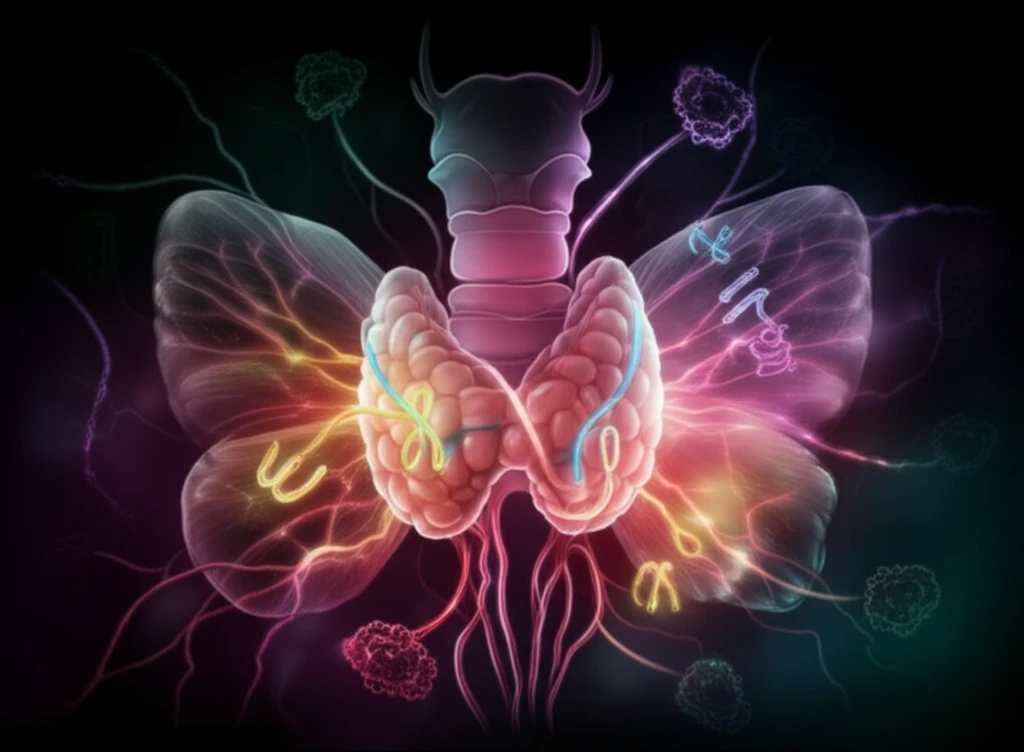
Thyroid Cancer and Hormones: Unlocking the Estrogen Connection
"Discover how estrogen and progesterone receptors influence papillary thyroid carcinoma, impacting treatment and prognosis."
Thyroid cancer, the most common malignancy of the endocrine system, includes several types, with papillary thyroid carcinoma (PTC) being the most prevalent, accounting for approximately 80% of cases. While risk factors such as ionizing radiation exposure are known, the striking female predominance in thyroid cancer incidence suggests hormonal influences might play a crucial role.
Estrogens, key hormones in female physiology, are increasingly recognized for their potential involvement in thyroid cancer development. These hormones can promote the proliferation and invasion of mutated epithelial follicular cells, contributing to the progression of papillary carcinoma. Understanding how estrogen and its receptors behave in thyroid cancer cells is crucial for improving treatment approaches.
This article delves into the role of estrogen and progesterone receptors (ER and PR) in papillary thyroid carcinoma (PTC). By examining the expression of these receptors and correlating them with clinical and pathological characteristics, we aim to provide insights into the hormonal dynamics of thyroid cancer and explore potential therapeutic implications.
How Do Estrogen and Progesterone Receptors Impact Thyroid Cancer?

A recent study analyzed 62 primary and six metastatic papillary thyroid carcinoma cases to assess the expression of ER-a and PR. The findings revealed that 19% of primary PTC cases showed positive nuclear expression for ER, while 38.7% were positive for PR. Interestingly, metastatic cases displayed a higher ER positivity rate (66.7%), but all were negative for PR.
- ER Expression in Metastatic Cases: The significantly higher ER positivity in metastatic cases compared to primary PTC (p = 0.02) suggests that estrogen receptor expression may play a role in the metastatic process.
- Association with Thyroiditis: ER expression was significantly associated with primary PTC cases that also presented with thyroiditis (p = 0.002), indicating a potential link between inflammation and estrogen signaling in thyroid cancer.
- PR Expression and Age: Progesterone receptor expression was significantly associated with older age in primary PTC patients (p = 0.003), implying that PR activity may be influenced by age-related factors.
- Co-expression of ER and PR: The study found a significant co-parallel expression of ER and PR (p = 0.000), suggesting that these receptors may work together in thyroid cancer cells.
What's Next? Future Directions for Research and Treatment
The discovery that estrogen and progesterone receptors are expressed in papillary thyroid carcinoma opens new avenues for research and potential therapeutic interventions. Further studies are warranted to investigate whether patients with ER-positive or PR-positive tumors might benefit from hormonal therapies. Additionally, understanding the relationship between estrogen receptor expression and metastasis could lead to more targeted treatment strategies for advanced thyroid cancer. Specifically, exploring the role of lymphocytes in the stroma and their potential promotion of ER expression in adjacent PTC warrants further investigation, particularly in cases associated with Hashimoto's thyroiditis.
